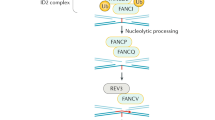Summary
An increased chromosomal breakage rate (ICBR) was found in 27 of 28 patients with scleroderma (systemic sclerosis, SS)-5 with the syndrome including calcinosis cutis, Raynaud phenomenon, esophagus hypomotility, sclerodactyly and telangiectasia (CREST), 4 incomplete CREST, 1 overlapping syndrome, 18 progressive systemic sclerosis (PSS). Not only the patients, but also about half of their first-degree relatives showed an increased chromosomal breakage rate (more than 5 breaks per 100 metaphases). This character segregated as a dominant marker in nine families of scleroderma patients. In the six informative of the nine families, the ICBR trait showed close linkage with the HLA region on chromosome 6 (total lod score 5.5 at θ=0). In these families, ICBR was predominantly observed in linkage with HLA haplotype A1, Cw7, B8, C4AQ0B1, DR3 which is frequently observed in autoimmune diseases. The nature of the agent inducing chromosomal breakage in cultured lymphocytes of some, but not all family members of scleroderma patients remains to be clarified.
Similar content being viewed by others
References
Black CM, Welsh KI, Maddison PJ, Jayson MIV, Bernstein RM (1984) HLA antigens, autoantibodies and clinical subsets in scleroderma. Br J Rheumatol 23:267–271
Briggs DC, Welsh KI, Pereira RS, Black CM (1987a) A strong association between null alleles at the C4 locus in the major histocompatibility complex and systemic sclerosis. Arthritis Rheum 29: 1274–1277
Briggs DC, Donaldson PT, Hayes P, Welsh KI, Williams R, Neuberger JM (1987b) A major histocompatibility complex class III allotype (C4B 2) associated with primarjy biliary cirrhosis (PBC). Tissue Antigens 29:141–145
Carroll MC, Palsdottir A, Belt KT, Porter RR (1985) Deletion of complement C4 and steroid 21-hydroxylase genes in the HLA class III region. EMBO J 4:2547–2552
Dausset J (1976) Clinical implications (nosology, diagnosis, prognosis and preventive therapy). In: Dausset J, Svejgaard A (eds) HLA and disease. Munksgaard, Copenhagen/Williams & Wilkins, Baltimore, pp 296–310
Emerit I (1980) Chromosomal instability in collagen disease. Z Rheumatol 39:84–90
Emerit I, Marteau R (1971) Chromosome studies in 14 patients with disseminated sclerosis. Hum Genet 13:25–33
Emerit I, Housset E, Feingold J (1976) Chromosomal breakage and scleroderma: studies in family members. J Lab Clin Med 88:81–86
ISCN (1985) An international system for human cytogenetic nomenclature. Harnden DG, Klinger HP (eds) Published in collaboration with Cytogenet Cell Genet. Karger, Basel, pp 66–76
German J (1972) Genes which increase chromosomal instability in somatic cells and predispose to cancer. In: Steinberg AG, Bearn AG (eds) Progress in medical genetics, vol 8. Grune & Stratton, New York, pp 61–101
Kelley WN, Harris ED, Ruddy S, Sledge CB (eds) (1981) Textbook of rheumatology. Saunders, Philadelphia London Toronto
LeRoy EC (1981) Scleroderma (systemic sclerosis). In: Kelley WN, Harris ED, Ruddy S, Sledge CB (eds) Textbook of rheumatology. Saunders, Philadelphia. London Toronto, pp 1211–1230
Levy A, Emerit I, Feingold J (1982) Chromosomal instability in NZB/BL mice — a dominant trait. Biomedicine 36:35–38
Maddison PJ, Skinner RP, Pereira RS, Black CM, Ansell B, Jayson MIV, Rowell NR, Welsh KI (1986) Antinuclear antibodies in the relatives and spouses of patients with systemic sclerosis. Ann Rheum Dis 45:793–799
Manns M, Bremm A, Gerken G, Prager M, Stradmann B, Meyer zum Büschenfelde KH Rittner C (1987) HLA-class I–III genes in primary biliary cirrhosis (PBC). American Gastroenterological Association, Chicago 1987 (abstr)
Mollenhauer E, Schmidt RE, Heinrich M, Rittner C (1984) Scleroderma: possible significance of silent alleles at the C4B locus. Arthritis Rheum 27:711–712
Moorhead PM, Nowell IC, Mellman WJ, Battips DM, Hungerford D (1960) Chromosome preparations of leucocytes cultured from human peripheral blood. Exp Cell Res 220:613–616
Morton NE (1955) Sequential tests for the detection of linkage. Am J Hum Genet 7:277–318
Ott J (1974) Estimation of the recombination fraction in human pedigrees: efficient computation of the likelihood, for human linkage studies. Am J Hum Genet 26:588–597
Rittner C (1983) Chromosomes and complement in scleroderma. Proceedings of the Scleroderma Symposium, London 1983, pp 23–28
Rittner C, Kühnl P, Black CM, Pereira S, Welsh KI (1984a) Scleroderma: possible association with the C4 system — a progress report. In: Albert ED, Baur MP, Mayr WR (eds) Histocompatibility testing 1984. Springer, Berlin Heidelberg New York, pp 394–397
Rittner C, Giles CM, Roos MH, Demant P, Mollenhauer E (1984b) Genetics of human C4 polymorphism: detection and segregation of rare and duplicated hapotypes. Immunogenetics 19:321–333
Roos MH, Giles CM, Demant P, Mollenhauer E, Rittner C (1984) Rodgers (Rg) and Chido (Ch) determinants on human C4: characterization of two C4 B5 subtypes, one of which contains Rg and Ch determinats. J Immunol 133:2634–2640
Schneider PM, Rittner C, Carroll MC, Colten HR (1985) Genomic structure of the C4 and 21-OH loci in a family with a C4A (Ch+) gene product. Complement 2:17 (abstr)
Schneider PM, Carroll MC, Alper CA, Rittner C, Whitehead AS, Yunis EJ, Colten HR (1986) Polymorphism of the human complement C4 and steroid 21-hydroxylase genes. J Clin Invest 78: 650–657
Tiwari JL, Terasaki PI (1985) HLA and disease associations. Springer; New York Berlin Heidelberg
Author information
Authors and Affiliations
Rights and permissions
About this article
Cite this article
Rittner, G., Schwanitz, G., Baur, M.P. et al. Family studies in scleroderma (systemic sclerosis) demonstrating an HLA-linked increased chromosomal breakage rate in cultured lymphocytes. Hum Genet 81, 64–70 (1988). https://doi.org/10.1007/BF00283732
Received:
Revised:
Issue Date:
DOI: https://doi.org/10.1007/BF00283732




